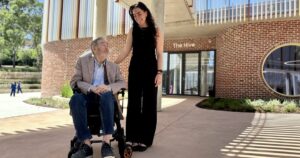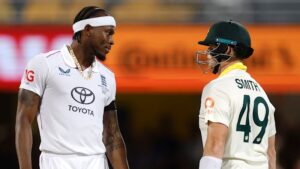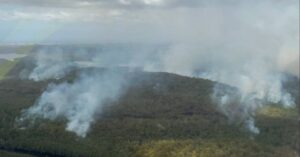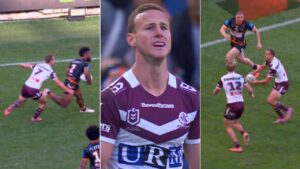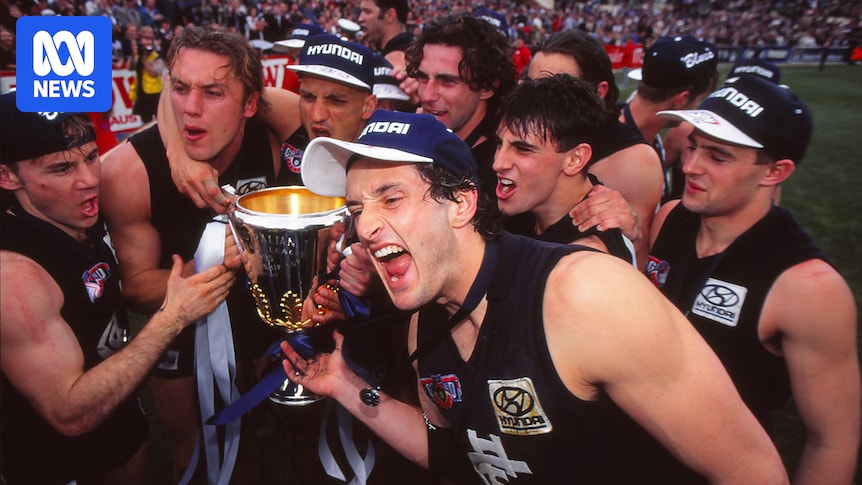
Shadowed by the colossus of the Great Southern Stand, respected Carlton administrator Shane O’Sullivan stood with his newest recruit and stared out at the expanse before them. The fresh-faced teenager from Adelaide next to him had only recently arrived for an induction weekend, having been snapped up with pick 15 in the 1994 AFL draft. “Have you ever been to the MCG?” O’Sullivan asked the kid on his first day at Princes Park. The answer was a definitive no.
Part of Shane O’Sullivan’s job in 1995 was to integrate the new players into the Carlton system and show them the ropes. The intimidating bustle of Melbourne was a world away from the charming tranquillity of Woodville Oval in the suburbs of the South Australian capital. O’Sullivan’s job was to integrate the new guys into the system, and integration meant controlling intimidation. And few things were more intimidating than the ‘G.
“Round one we’ll be playing Collingwood here, mate,” O’Sullivan said to the kid as they cast their eyes over the thousands of empty seats. “There’s probably gonna be about 85,000 people. You reckon you’d like playing in front of that?” The kid nodded. He wasn’t convinced it would happen — this was a Carlton side packed with generational talent after all — but he knew he wanted it. Confidence, lacking in some new arrivals, was not an issue for Scott Camporeale. He had it in spades.
The Journey to AFL Stardom
Just weeks later, on April 2, 1995, the 19-year-old pulled on the number 16 navy blue guernsey for the first time, and ran up the race onto the MCG in front of 87,119 screaming supporters. By the end of the season, the kid from Woodville-West Torrens would write himself into the history books as a Carlton legend.
Five players debuted for Carlton in 1995, but Camporeale was the only one that had been brought in via that season’s national draft. Held on October 28 of 1994, the draft was far from today’s glamorous, controlled show of families celebrating as their AFL dreams become a reality.
“I was actually sitting in a trade school exam at Regency Park back here in Adelaide when it was happening,” Camporeale recalls. “Carlton was one of the teams I hadn’t spoken to at all. I thought I was going to Melbourne. Neil Balme was the coach there and he’d been coach at Woodville-West Torrens, so he’d seen me through the juniors. So I get out of the exam and mum rings me. She says ‘you’re going to Melbourne’. So I thought, yeah that’s OK, that’s what I expected. And then she says ‘no, no, no, you’re moving to Melbourne, but you’re playing for Carlton.’ I said ‘well mum, that’s a bit different’.
“I asked Shane O’Sullivan at the time, I said to him ‘you didn’t say anything to me before the draft’,” Camporeale says. “And he said ‘well we didn’t want anyone to know we were going to pick you’.”
Integrating into a Powerhouse Team
Still on the cusp of full professionalism, the AFL remained a flimsy career path for anyone who came to it without a back-up plan. For Camporeale, that plan was seeing out what he had started in the exam room on draft day. “I was doing an electrician’s apprenticeship so I couldn’t move over straight away,” he says. “I was training here and there and flew over on a couple of occasions, but it wasn’t until after the Christmas break that I properly moved to Melbourne.”
It was then that ‘Campo’ integrated himself into one of the most intimidating Blues squads in the history of the game. For Carlton, the seven seasons from their 1987 premiership victory to the start of 1995 had been a mixed bag of close but no cigar, or no cigar offered at all. They’d lost the semi and preliminary finals in 1988, then missed the finals altogether up until 1993, when they made the grand final and somehow lost to the Baby Bombers, a team of destiny that had no right to even be in the same weight division as the hook-throwing, uppercut-launching heavyweight Blues.
“There were some of my all-time favourites from South Australia in that team,” Camporeale says. “To turn up at the club and have Steve Kernahan as your captain. Craig Bradley was there. Andrew McKay, he was a big brother to me when I arrived. So I felt like there was no expectation on me as a new recruit. These guys, like (Greg) Williams, and (Stephen) Silvagni, and (Earl) Spalding … the way they finished in 1993 and 1994, they had a fair bit of drive about them. I just went in head down and went about my way. But eventually you do get to the point where you’re thinking ‘how do I get into this team?’.
Breaking Through to the Big League
Through the pre-season, coach David Parkin had been running match simulations between two squads. In the blue training guernsey, the “probables” — the blokes most likely to take on Collingwood in that opening match. And in the white, the “possibles” — a mix of players on the brink of arriving, and those who had barely left the house.
“I was on the ‘possible’ team for most of the preseason, but I remember it clearly, I played one match simulation for the ‘possibles’ on the wing and I played really well,” Camporeale says. “So the next training session I have a look at the whiteboard and I’ve been flipped to the other side. And then that’s the thing, you get into that ‘probable’ team and suddenly you’re surrounded by the best players at the club, and they make you look better by association. You know, I think I did bring something different. They needed that speed on the wing and that’s why they drafted me. They already had Hall of Famers down the spine. I didn’t feel any real pressure, probably more the pressure I put on myself. But I knew then that I was a chance for round one.”
Debut Day: Carlton vs. Collingwood
Deafening. That’s the one common adjective used between Clape and Camporeale when describing that first game against Collingwood. “The biggest thing is the deafening noise,” Camporeale says. “You go from the SANFL where there’s smaller crowds, to playing in front of that. You scream for the ball and nobody can hear you.”
Clape, as predicted, would get the start at half forward, while Camporeale headed out to a wing. “I was pretty lucky, it was Sticks’s [Kernahan’s] 200th game so nobody gave a rat’s arse about me,” Camporeale says. “But I do remember my first kick. I took off with the ball and passed it inside 50, straight over Sticks’s head in his milestone game, so it wasn’t a great start. That sort of got rid of the nerves though and away we went from there.”
The Blues led by seven points at quarter-time and to that point Clape had been solid, but was yet to trouble the scorers in his new role up forward. “For me it was a second chance,” Clape says. “So my aim was to just do the right things, really concentrate on what the coaches wanted me to do and hopefully get my hands on the ball.”
In the second quarter, Clape’s first major for the navy Blues came via textbook medium forward footy. After teammate Brad Pearce had brought the ball to ground in a marking contest, Clape burst through the pack and took the pill cleanly, before his momentum was halted by a Craig Kelly tackle. Handballing while being turned 360 in the tackle, Clape found an open Pearce, who then passed back to Clape, who had somehow kept his balance after the pirouette in the forward pocket, before running into an open goalsquare for the six points.
His second of the quarter came via a set shot 35 metres out, after getting on the end of a hurried Camporeale kick forward, as the two newbies teamed up to increase the Carlton lead. “He’s added a bit of flavour to that forward line,” commentator Ian Robertson said during the call.
By the final term, Clape had his third via a strong contested mark against star Magpies fullback Gary Pert. The West Coast recruit would be Carlton’s top scorer on the day, as the Blues ran out 29 point winners. Camporeale collected 19 disposals, behind only superstars Bradley, Williams, McKay, Brett Ratten and Anthony Koutoufides. It was the first in a run of seven victories, before mid-season disaster appeared to strike.
Mid-Season Challenges and Triumphs
To say that few people saw what was coming in rounds eight and nine of the 1995 season would be generous, because what happened baffles the most ardent of footy pundits even to this day. With seven straight victories under their belts — including a three-game run where they knocked off potential contenders North Melbourne, West Coast, and Essendon — Carlton’s season was stopped dead its tracks by two Davids looking to shatter the resolve of the mighty Goliath decked out in his navy blue tunic.
The first blow was dealt via a Swans team that had finished dead last in 1994, but now had the formidable weapon of Tony Lockett attached to its belt, hurling his mighty frame at the Carlton defence at the SCG. Lockett would kick eight goals to go along with fourth-gamer Michael O’Loughlin’s bag of four, as the Swans stunned the Blues with a 72-point belting.
The next week, Carlton headed to a freezing Waverley Park to take on St Kilda, who had spent three of the first eight rounds in the wooden spoon spot. The now Lockett-less Saints looked in every way to be a team that would be shocked and awed as they grasped and clawed at the rampaging might of the premiership favourites. Instead, they ran out 56-point winners, restricting the Blues to just three goals as Stewart Loewe (5.2) outscored the hapless Carlton squad by eight points off his own boot.
“We had a history of not playing well at the SCG and there was no other reason for that loss other than we just didn’t play our style of football,” Clape says. “Then the St Kilda game. My form had started to wane by then so I was playing off the bench, and it was pouring with rain and freezing cold and it was just a nightmare sort of day.”
Camporeale had remained a shining light through both games, having been the second-most prolific ball-winner in the Swans loss, and being one of only three Blues to trouble the scorers against the Saints. “I think we saw it as a bit of an anomaly,” Camporeale says. “There wasn’t really any panic. It was a bit of a wake-up call and we knew we shouldn’t be dropping games to those sort of teams. But there was a real confidence in the group that despite those games, we thought we were still the best team in the competition.”
For coach Parkin though, the slip-ups were enough for him to think about tinkering with the starting team. Simon Beaumont had been taken with pick 18 in the 1993 draft, but hadn’t been near debuting in 1994 in a first season at Princes Park where he described himself as “raw”.
“I hadn’t played a great deal of under-18 footy. I’d had just the one year in the system and got injured mid-year,” Beaumont, who now works in risk management with the Commonwealth Bank, says. “I certainly needed that 12 months development in the VFL before I was ready to play at the next level. To be honest, my first year [at the Blues] was pretty ordinary and I was lucky to get a second year at the end of the day. But Carlton had a pretty old list and had some retirements, so it meant there were a couple of extra spots at the end of the season and I survived.”
With Ken Judge coming in as reserves coach, and an extra six or seven kilos added to his growing frame, Beaumont was given more of a chance to run through the midfield and play forward, impressing more and more as the season went on. By round 10, it was his turn to find his name highlighted on Col Kinnear’s list after Thursday training.
“They’d have their match committee after training, so the coaches would go into a room, and they’d be there for an hour, maybe an hour-and-a-half,” Beaumont says. “Then there would be six or seven of us on the fringes who just had to wait around for them to come out with that list. They wouldn’t tell you that you were in or out, it was just look at the list and go from there.”
With the Hawks next up at Princes Park following Carlton’s two shock losses, Beaumont would have to bide his time further on the bench, as the Blues went out with a mission to prove those last couple of games had been nothing but a blip on their usually immaculate radar.
“By the time I came on halfway through the second quarter I reckon we were already 60 points up,” he says. “You’re running up and down the boundary line trying to get the coach’s attention so you can get a run. But honestly, that first game is just surreal, you cannot believe you get to run out with guys like Stephen Kernahan and Greg Williams and Peter Dean and Harry Madden. I used to idolise them running out and playing with them.”
When Beaumont did finally get his chance, he took it with both hands, joining the exclusive club of kicking a goal with his very first kick in the big league, having got on the end of a bullet pass from Andrew McKay in front of Hawthorn debutant Daniel Harford. His veteran Carlton teammates flocked to him after the kick, in scenes that are common today, but were less so 30 years ago.
“[Harford] obviously had a very different experience in his first game, being on a losing side,” Beaumont says. “And I remember my second kick hit the post. So it was good to get involved but I was lucky to debut in a game where we were never going to lose. I just remember feeling very confident running out there with those guys. I just felt safe and protected.”
It was a 102-point flogging of the Hawks, but Parkin still wasn’t done with his tinkering. Two more players would debut, and one would become an integral part of the success that was to come.
The Road to the Grand Final
Glenn Manton has made no secret of the tumultuous exit he made at Essendon. Now a motivational speaker and author, Manton had worked his way through the junior ranks of the Bombers before playing 21 senior games over three seasons from 1992 to 1995. “I thought that 1995 was going to be my year to really step forward at the Essendon Football Club and announce myself as a regular team member,” the 52-year-old Manton says between weights sets during a workout. “History now shows it was my time to step forward and out the door at the Essendon Football Club and find myself delisted for the second time.”
Recently describing Essendon coach Kevin Sheedy as a “plumber and knockabout sort” compared to Parkin as an “educator and cerebral thinker”, Manton and the Bombers never truly clicked, with the self-described “Swiss army knife” on the field saying he felt certain people at Windy Hill had handcuffed him while at the club. It was that uncomfortable relationship that saw him without a footballing home coming into the 1995 season.
“I
